In the following pages the scheme of graphic illustration, intended both to save labor and secure accuracy, which was presented in the Introduction to the Study of Sign Language, is reproduced with some improvements. It is given for the use of observers who may not see that publication, the material parts of which being included in the present paper it is not necessary that the former should now be furnished. The Types of Hand Positions were prepared for reference by the corresponding letters of the alphabet to avoid tedious description, should any of them exactly correspond, or by alteration, as suggested in the note following them. These, as well as the Outlines of Arm Positions, giving front and side outline’s with arms pendant, were distributed in separate sheets to observers for their convenience in recording, and this will still be cheerfully done when request is made to the present writer. When the sheets are not accessible the Types can be used for graphic changes by tracing the one selected, or by a few words indicating the change, as shown in the Examples. The Outlines of Arm Positions can also be readily traced for the same use as if the sheets had been provided. It is hoped that this scheme, promoting uniformity in description and illustration, will be adopted by all observers who cannot be specially addressed.
Collaborators in the gestures of foreign uncivilized peoples will confer a favor by sending at least one photograph or sketch in native costume of a typical individual of the tribe, the gestures of which are reported upon, in order that it may be reproduced in the complete work. Such photograph or sketch need not be made in the execution of any particular gesture, which can be done by artists engaged on the work, but would be still more acceptable if it could be so made.
Outlines for Arm Positions in Sign Language
The gestures, to be indicated by corrected positions of arms and by dotted lines showing the motion from the initial to the final positions (which, are severally marked by an arrow-head and a crosssee Examples), will always be shown as they appear to an observer facing the gesturer, the front outline, Fig. 340, or side, Fig. 341, or both, being used as most convenient. The special positions of hands and fingers will be designated by reference to the Types of Hand Positions. For brevity in the written description, “hand” may be used for “right hand,” when that one alone is employed in any particular gesture. When more convenient to use the profile figure in which the right arm is exhibited for a gesture actually made by the left hand and arm it can be done, the fact, however, being noted.
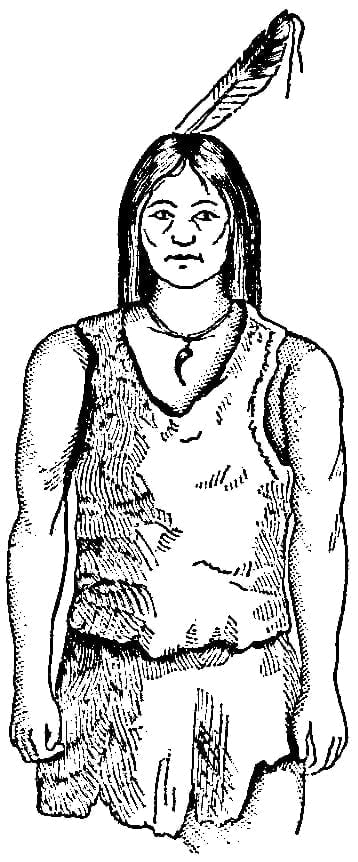
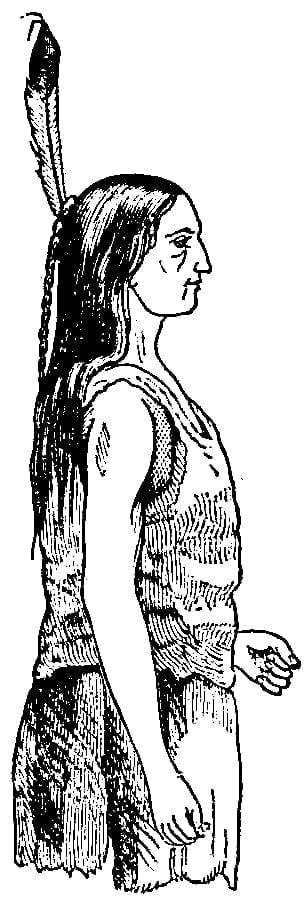
In cases where the conception or origin of any sign is ascertained or suggested it should be annexed to the description, and when obtained from the gesturer will be so stated affirmatively, otherwise it will be considered to be presented by the observer. The graphic illustration of associated facial expression or bodily posture which may accentuate or qualify a gesture is necessarily left to the ingenuity of the contributor.
Order of Arrangement
The following order of arrangement for written descriptions is suggested. The use of a separate sheet or part sheet of paper for each sign described and illustrated would be convenient in the collation. It should always be affirmatively stated whether the “conception or origin” of the sign was procured from the sign-maker, or is suggested or inferred by the observer.
Word or idea expressed by Sign: __________________
DESCRIPTION:
____________________________________________________
____________________________________________________
____________________________________________________
CONCEPTION OR ORIGIN:
____________________________________________________
Tribe: ________________________________
Locality:______________________________
Date: _____________________ 188_.
__________________________
Observer.
Types of Hand Positions in Sign Language
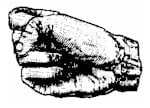 A – Fist, palm outward, horizontal. |  B – Fist, back outward, oblique upward. |
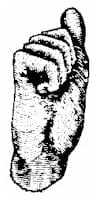 C – Clinched, with thumb extended against forefinger, upright edge outward. | 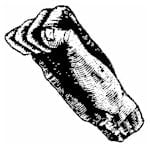 D – Clinched, ball of thumb against middle of forefinger, oblique, upward, palm down |
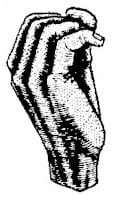 E – Hooked, thumb against end of forefinger, upright, edge outward. | 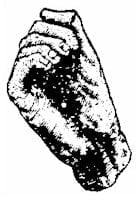 F – Hooked, thumb against side of forefinger, oblique, palm outward. |
 G – Fingers resting against ball of thumb, back upward. |  H – Arched, thumb horizontal against end of forefinger, back upward. |
 I – Closed, except forefinger crooked against end of thumb, upright, palm outward. |  J – Forefinger straight, upright, others closed, edge outward. |
 K – Forefinger obliquely extended upward, others closed, edge outward. |  L – Thumb vertical, forefinger horizontal, others closed, edge outward. |
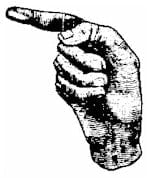 M – Forefinger horizontal, fingers and thumb closed, palm outward. |  N – First and second fingers straight upward and separated, remaining fingers and thumb closed, palm outward. |
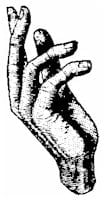 O – Thumb, first and second fingers separated, straight upward, remaining fingers curved edge outward. |  P – Fingers and thumb partially curved upward and separated, knuckles outward. |
 Q – Fingers and thumb, separated, slightly curved, downward. | 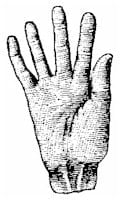 R – Fingers and thumb extended straight, separated, upward. |
 S – Hand and fingers upright, joined, back outward. |  T – Hand and fingers upright, joined, palm outward. |
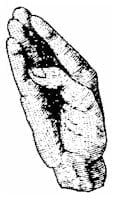 U – Fingers collected to a point, thumb resting in middle. |  V – Arched, joined, thumb resting near end of forefinger, downward. |
 W – Hand horizontal, flat, palm downward. |  X – Hand horizontal, flat, palm upward. |
 Y – Naturally relaxed, normal; used when hand simply follows arm with no intentional disposition. | |
Note Concerning the Foregoing Types
The positions are given as they appear to an observer facing the gesturer, and are designed to show the relations of the fingers to the hand rather than the positions of the hand relative to the body, which must be shown by the outlines (see Outlines of Arm Positions) or description. The right and left hands are figured above without discrimination, but in description or reference the right hand will be understood when the left is not specified. The hands as figured can also with proper intimation be applied with changes either upward, downward, or inclined to either side, so long as the relative positions of the fingers are retained, and when in that respect no one of the types exactly corresponds with a sign observed, modifications may be made by pen or pencil on that one of the types, or a tracing of it, found most convenient, as indicated in the Examples, and referred to by the letter of the alphabet under the type changed, with the addition of a numeral—e.g., A 1, and if that type, i.e., A, were changed a second time by the observer (which change would necessarily be drawn on another sheet of types or another tracing of a type selected when there are no sheets provided), it should be referred to as A 2.
Examples
Word or idea expressed by sign: To cut, with an ax.
DESCRIPTION.
With the right hand flattened (X changed to right instead of left), palm upward, move it downward to the left side repeatedly from different elevations, ending each stroke at the same point. Fig. 343.
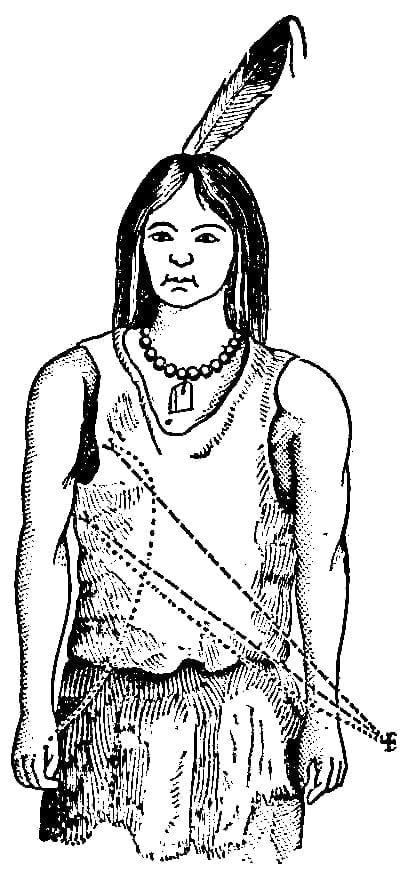
CONCEPTION OR ORIGIN.
From the act of felling a tree.
Word or idea expressed by sign: A lie.
DESCRIPTION.
Touch the left breast over the heart, and pass the hand forward from the mouth, the two first fingers only being extended and slightly separated (L, 1—with thumb resting on third finger, Fig. 344a). Fig. 344.

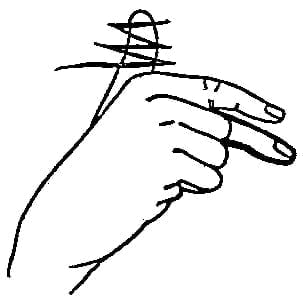
CONCEPTION OR ORIGIN.
Double-tongued.
Word or idea expressed by sign: To ride.
DESCRIPTION.
Place the first two fingers of the right hand, thumb extended (N 1, Fig. 345a) downward, astraddle the first two joined and straight fingers of the left (T 1, Fig. 345b), sidewise, to the right, then make several short, arched movements forward with hands so joined. Fig. 345.
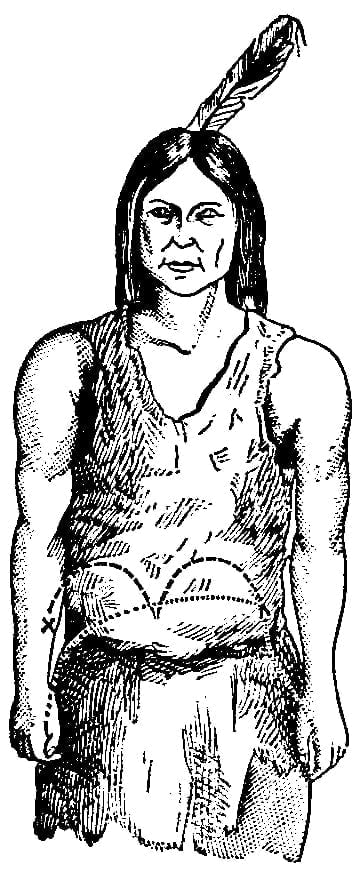
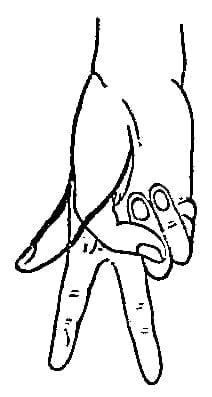
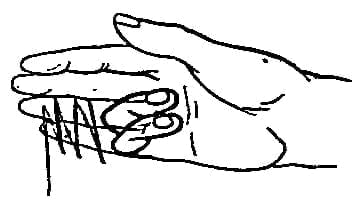
CONCEPTION OR ORIGIN.
The horse mounted and in motion.
Word or idea expressed by signs: I am going home.
DESCRIPTION.
(1) Touch the middle of the breast with the extended index (K), then (2) pass it slowly downward and outward to the right, and when the hand is at arm’s length, at the height of the shoulder, (3) clinch it (A) suddenly and throw it edgewise toward the ground. Fig. 346.
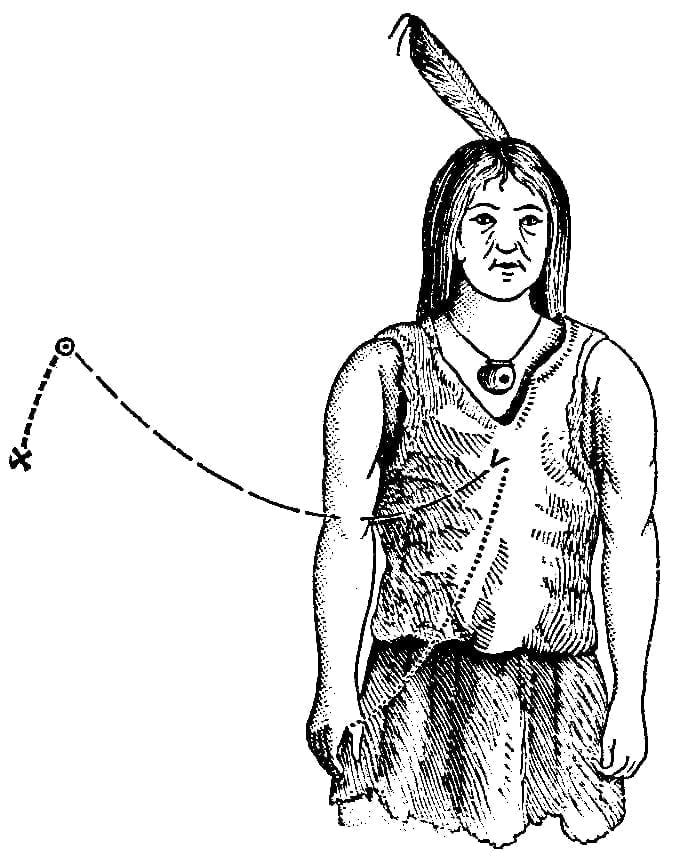
CONCEPTION OR ORIGIN.
(1) I, personality; (2) motion and direction; (3) locality of my possessions—home.
Explanation of Marks
The following indicative marks are used in the above examples:
·············Dotted lines indicate movements to place the hand and arm in position to commence the sign and not forming part of it.
————-Short dashes indicate the course of hand employed in the sign, when made rapidly.
— — — — — Longer dashes indicate a less rapid movement.
—— —— —— Broken lines represent slow movement.
> Indicates commencement of movement in representing sign, or part of sign.
× Represents the termination of movements.
☉ Indicates the point in the gesture line at which the hand position is changed.
